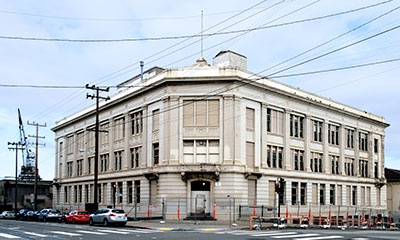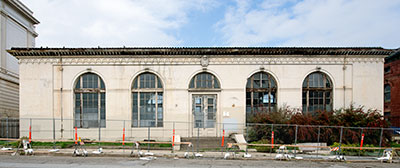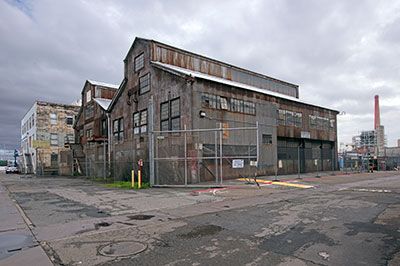National Register of Historic Places in San Francisco
Union Iron Works Historic District
Bounded by Illinois, 18th, 22nd Streets
Founded 1884
The Union Iron Works Historic District, while retaining the essence of its original design, typifies subsequent changes in shipyard design up to the end of World War II in 1945.
The early history of Union Iron Works (UIW) coincides with the shift from wood to iron shipbuilding. By opening the first steel shipyard on the West Coast in 1884, UIW established a national steel hull shipbuilding industry.
Over the next three decades, the shipyard played an integral role in the United States government's efforts to increase naval resources and bolster the nation's image as an international military power. By World War I, the yard stood at the center of the shipbuilding industry on the West Coast. A crew of mostly skilled laborers produced dozens of warships and submarines that resulted in the United States' overwhelming success in World War I.
Between the World Wars, the shipyard's ability to build and repair all ships afloat kept it profitable. As World War II approached, UIW participated in the unprecedented military build-up. During World War II, ship repair and naval contracts made a significant contribution to the war.
Over the decades, UIW maintained and used many of the older buildings. The result is a unique collection of buildings from all periods of the steel shipbuilding industry in the United States.
Source: Adapted from the NRHP nomination.

The following is a partial list of the thirty-eight buildings, two sites and four structures which contribute to the historic district.
| Name | Year | Address | Remarks | Sort Address | Sort Name |
|---|---|---|---|---|---|
| Union Iron Works Main Office | 1917 | Building 101 (20th and Illinois Streets) | Architect Frederick H. Meyer | B101 | Union Iron Works Main Office |
| Powerhouse | 1912 | Building 102 (20th Street) | Architect Charles Peter Weeks. Spanish Renaissance revival. | B102 | Powerhouse |
| Steam Powerhouse No. 2 | 1937 | Building 103 (20th Street) | B103 | Steam Powerhouse No. 2 | |
| Union Ironn Works Office Building and Industrial Relations Building | 1896 | Building 104 (20th Street) | Architects Percy & Hamilton. Renaissance Revival. | B104 | Union Ironn Works Office Building and Industrial Relations Building |
| Noonan Building | 1941 | Building 11 | Woodframe building used as tool room and office. | B011 | Noonan Building |
| Substation No. 5 | 1900 | Building 21 | Industrial-vernacular building which is the only surviving building from the Risdon Iron and Locomotive Works which closed in 1911. | B021 | Substation No. 5 |



